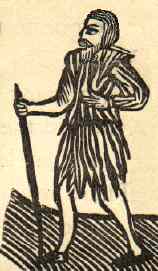The social background: violence and madness
King Lear has one scene which is exceptionally ugly in its brutality: the blinding of Gloucester. While such penalties were no longer inflicted in Shakespeare's England, his audience was familiar with extreme punishment.
As they went on their way to the play, members of his audience would probably have seen the heads of traitors stuck on poles over the entrance to London Bridge; and the theatre itself, where they saw the play, would have been on other days the venue of the brutal sport of bear-baiting.
Less obviously violent, but no less disturbing, is the madness in the play, from the mild satire of the Fool*, to the feigned ravings of Edgar as Poor Tom, to the pathos of Lear's extreme madness.
Footnotes
-
Surrounded by fools
In the first performances of Lear, the Fool would have been played by the talented Robert Armin.
Jesters and Fools were an accepted part of Courts of the Renaissance. Lear's Fools fits into the pattern of the "artificial"--intelligent--fools of the later Renaissance. Click for more on fools.
